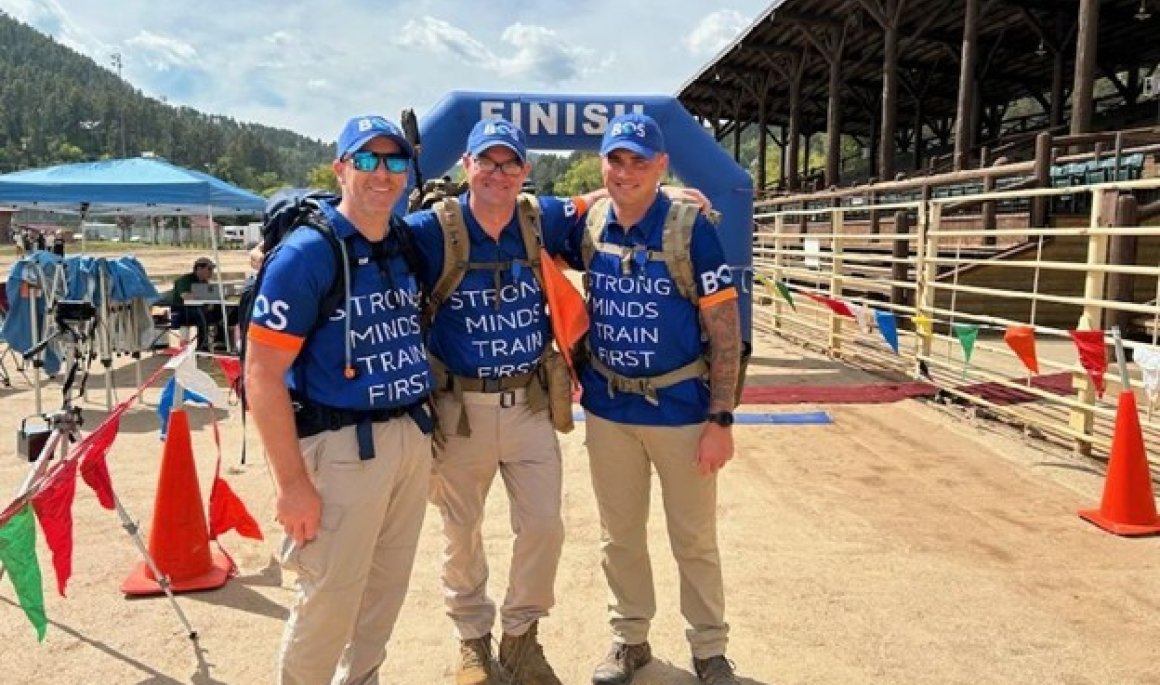- Norwich Blogs
- Blogs
- Chasing Partridge in the Black Hills
Chasing Partridge in the Black Hills
By Dr. Franklin C. Annis & Mr. Jeffrey "Jace" Rivard
For the purpose of accustoming the cadets to hardship and fatigue, and also for the purpose of instructing them more perfectly in the practical duties of the soldier, they will perform at least one march as a military corps, each year. – Captain Alden Partridge, Prospectus, 1825

Disclaimer: These opinion pieces represent the authors’ personal views and do not necessarily reflect the official policies or positions of Norwich University or PAWC.
On 20 September 2025, Jace Rivard, Norwich University Class of 2010, was a member of the first 110-mile endurance team to cross the finish line in the Black Hills Veteran March. Trekking his way through the Black Hills of South Dakota on the George S. Mickelson Trail, Jace copied the “pedestrian adventures” used by Captain Alden Partridge in the early days of Norwich University. Upon the march, the team discussed many of the academic fields of the original curriculum, from Stoic philosophy and its ability to improve psychological resilience, to geology in examining rock formations, to engineering in inspecting railroad tunnels, to improving their coup d’œil through deliberating the military uses of the terrain they were walking through. Although it was two centuries removed from Partridge’s academies, Jace and his team reignited the legacy of Partridge over their 4-day adventure.
[W]alk at least ten miles each day, at a rate of four miles per hour;-about three to four times each year shoulder your knapsack, and, with your barometer, &c. ascend to the summits of our principal mountains, and determine the altitudes, walking from thirty to eighty miles per day, according as you can bear the fatigue- do all these, and I will insure you firm and vigorous constitutions. – Captain Alden Partridge, Journal of Health, 22 December 1830
About a year before the march, Jace found himself being hired into a new position with a supervisor who seemed to know a lot about Norwich University, or at least “Old Norwich,” but wasn’t an alumnus. He told stories of the old American Literary, Scientific, and Military Academy and asked questions about how many of Captain Alden Partridge’s practices were still retained at Norwich. Unfortunately, Jace’s supervisor, historian Dr. Franklin Annis, was often disappointed by the answers he received. With frequent conversations about Captain Partridge and the forgotten traditions of Norwich, it didn’t take long for Franklin to convince Jace to take up a marching practice of Partridgean fashion.
For over five years, Franklin had been engaging in single-day marches copying Partridge’s marching practices. While his marches had been as far as 62 miles (100 km) in a single day (falling shy of Partridge’s 70-mile record), Franklin longed for the chance to test his endurance through multiple-day marches. Recognizing that Jace lacked the experience and training to complete the Black Hills Veteran March, a three-month plan was developed to bring Jace up to speed and prepare them both for the challenge ahead. Training in the severe heat of the Virginia summers provided Franklin and Jace with the opportunity to become accustomed to the discomfort of the trail. A third member of their team, Ryan Collyer, who had previously marched the Bataan Memorial Death March with Franklin, conducted his own rigorous training on the trails around Calgary, Canada.
The Black Hills Veteran March is a 110-mile endurance event that takes place over four days. Starting at 5:00 a.m. in Edgemont, SD, the team faced the challenge of a 33-mile hike to Pringle, SD, along the historic railroad line. With threatening gray skies overhead, the team marched along a constant uphill grade. Approximately 20 miles in, the rain began to pour. Like the pedestrian adventure of 1821, after 11 hours on the trail, the exhausted team arrived “all in good health and spirits but, I believe, without a dry thread in our clothes.”
Day 2 of the march took the team on a 28-mile uphill trek from Pringle to Hill City, SD. While the team was spared from the hardship of rain, other difficulties of the trail became apparent. Sore muscles, blistered feet, still-wet equipment, and an inadequate appetite for the trail added to the team’s challenges. While their packs weighed a similar amount as early Norwich cadets, they were grateful not to be lugging around a 10 ½-pound musket.
Day 3 proved to be the most difficult. Despite heavy training, the team hadn’t developed their “trail legs.” Biological adaptations to the extreme march were still occurring. Despite the day having the shortest leg of the entire march at 23.7 miles, it proved to be the most psychologically taxing. For the 110-mile event, which was two miles longer than the Mickelson Trail it was on, the team had to walk an extra mile beyond the last rest stop before they could head back and finish the day’s course. Despite the fatigue of the day, there were some bright spots where the team could study historical railroad tunnels and the region’s geology.
Those Excursions, while they would learn them to walk (which I estimate an important part of Education) and render them vigorous and healthy, would also prepare them for becoming men of practical Science, generally, and would further confer on them a correct Coup-D’oeil, – So essentially necessary for military and Civil Engineers, for Surveyors, for travellers, &c – and which can never be acquired otherwise than by practice. – Captain Alden Partridge, Lecture on Education, 1825
Day 4, everything seemed to click. The team set off at 5 am at a brisk pace, hoping to gain as much of a lead on the marathon runners who would begin the course a couple of hours later. With the rhythmic sound of gravel crushing underfoot, the morning hours vanished. The fatigue of the course resolved into a pure determination to finish the trek. Midmorning, Jace broke the silence to ask, “Are we marching on Rome?” For indeed, it felt like the team was raiders singularly focused on closing with the enemy. Franklin commented, “Wouldn’t it be nice if we were the first team across the finish line?” From that point forward, the team was determined to make that optimistic thought a reality. No rest stops were taken that day. The team paused only for water resupply. Seven hours and 35 minutes after they started, the team had finished the marathon-length course of the day.
I read in Ancient History that the Spartan Soldiers marched from Sparta to Marathon said to be 150 miles—in those days—carrying their Armor and Provisions—the whole weighing about 70 pounds—that the Athenians made a formal march of 40 miles immediately after fighting the Battle of Marathon, in order to defend Athens from a Naval Attack of the Persians—that Euclid of Megara was in the practice of walking 40 miles in a night in order to visit his friend Socrates, and that Socrates, himself, the great Philosopher of Greece, was found in the ranks, fighting the Battle of his Country, and cheerfully enduring all the hardships, fatigues and privations of the most hardy soldier, I feel my own infirmints [sp] and am sensibly impressed with the conviction of modern degeneracy. – Captain Alden Partridge, Letter to Gales & Seaton of the National Intelligencer, 1829
The team was proud to march in the colors of the Before Operational Stress (BOS) program. BOS is an evidence-informed program specifically designed for military service members, public safety personnel, and first responders. The program was developed by leading mental health experts and psychologists to provide frontline workers with practical tools for managing operational stress. The success of this program lies in the Stoic ethics that provides its foundation. The BOS program uses many of the Stoic concepts that were integrated into the original Norwich University curriculum. The team used this march to engage in what is now called Stoic Toughening Training. By engaging in voluntary discomfort, the team could build its psychological resilience to be better prepared for the hardships of life. In this way, the team didn’t just advance a philosophy; they lived it. Acta non verba, displaying actions not words.
For the purpose of accustoming the cadets to hardship and fatigue, and also for the purpose of instructing them more perfectly in the practical duties of the soldier, they will perform at least one march as a military corps, each year. – Captain Alden Partridge, Prospectus, 1825
The morning after the event, the team woke up, realizing they could have easily kept going. Like many others who have successfully completed an endurance event, the team’s personal limitations have been significantly reduced. The feeling of triumph was mixed with the question of what great feat would come next. The only problem with the accomplishment is that it came decades later for these men than it should have. Captain Alden Partridge would have had these types of experiences built into the curriculum of every American university. While Norwich University today maintains a focus on physical fitness among its cadet corps, the manner in which this training is conducted falls far short of Partridge’s intended vision. There was once a time when Norwich could boast that their cadets could “walk with facility 40 miles per day.”
We call upon Norwich University to reclaim its past and reimplement long marches into the curriculum for the benefit of both physical fitness and psychological resilience. Even the limited Norwich Legacy March is insufficient in duration and distance to drive the formational changes in “constitution” intended by Partridge. Yearly long marches should be a universal requirement for all Norwich students. The need for physically strong and psychologically resilient citizens has not waned over the centuries. As Partridge continually demonstrated, these pedestrian adventures were not a detriment to, but a fulfillment of, holistic education. Lectures are easily delivered on the route and often yield higher learning outcomes than those achieved in the classroom. Honor the founder who inspired a national hiking movement by teaching cadets to truly know how to march. Let alumni not be forced to finish their own education. Let Norwich cadets return to being rangers. Not rangers in the sense of a school, tab, or unit. But rangers in their ability to cover vast distances on foot. Let the mountains of New England be filled again with the Spartan visage of Norwich cadets on the march.
The views presented are those of the authors and do not necessarily represent the views of the Department of War or its components.
Dr. Franklin C. Annis is a military philosopher, historian, and educational theorist. He is the Author of “Marching with Spartans: The Life and Works of Alden Partridge.”
Jeffrey “Jace” Rivard is a 2010 Norwich University Corps of Cadets graduate with a Bachelor’s in Environmental Science. He’s a commissioned officer in the Vermont Army National Guard and currently serves on active duty at the Army National Guard Readiness Center in Arlington, VA, as the Health Systems Officer in the Office of the Chief Surgeon.



